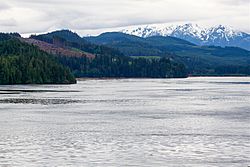Johnstone Strait facts for kids
Quick facts for kids Johnstone Strait |
|
|---|---|
| French: Détroit de Johnstone | |

Johnstone Strait backdropped by the Vancouver Island Ranges
|
|

Map of Johnstone Strait (bottom) and the surrounding islands and inlets
|
|
| Location | British Columbia, Canada |
| Coordinates | 50°28′0″N 126°05′0″W / 50.46667°N 126.08333°W |
| Type | Channel |
| Ocean/sea sources | Pacific Ocean |
Johnstone Strait (French: Détroit de Johnstone) is a long, narrow channel of water in British Columbia, Canada. It stretches for about 110 kilometers (68 miles) along the northeast coast of Vancouver Island. This strait is an important waterway for ships traveling along the west coast of North America. It connects to other waterways like Discovery Passage and the Pacific Ocean.
Contents
How Johnstone Strait Got Its Name
The strait was named by Captain George Vancouver. He named it after James Johnstone, who was the master of a ship called the Chatham. In 1792, Johnstone's survey team confirmed that Vancouver Island was indeed an island.
Where is Johnstone Strait?
Johnstone Strait is between 2.5 and 5 kilometers (1.5 to 3 miles) wide. It is a very important shipping route on the west coast of North America. Many large ships use this channel. They travel from the Strait of Georgia north of Vancouver Island to places like Prince Rupert, Haida Gwaii, and Alaska. Ships also use it when heading south to the Port of Vancouver.
There are no big cities or towns directly along the strait. However, smaller communities like Telegraph Cove and Robson Bight are located near its northern end on Vancouver Island. The village of Sayward is closer to the middle of the strait.
Amazing Wildlife: Orcas in the Strait

Johnstone Strait is famous for being home to about 150 orcas during the summer months. These amazing marine mammals are often seen by people on kayaks and tourist boats.
Scientists have been studying the orcas in the strait since 1970. Researchers like Michael Bigg and Paul Spong have learned a lot about these whales. Paul Spong even started a research center called OrcaLab. This lab focuses on studying orcas in their natural home without disturbing them. Part of the strait is protected as the Robson Bight (Michael Bigg) Ecological Reserve. This reserve helps keep the orcas safe.
See also
 In Spanish: Estrecho de Johnstone para niños
In Spanish: Estrecho de Johnstone para niños


